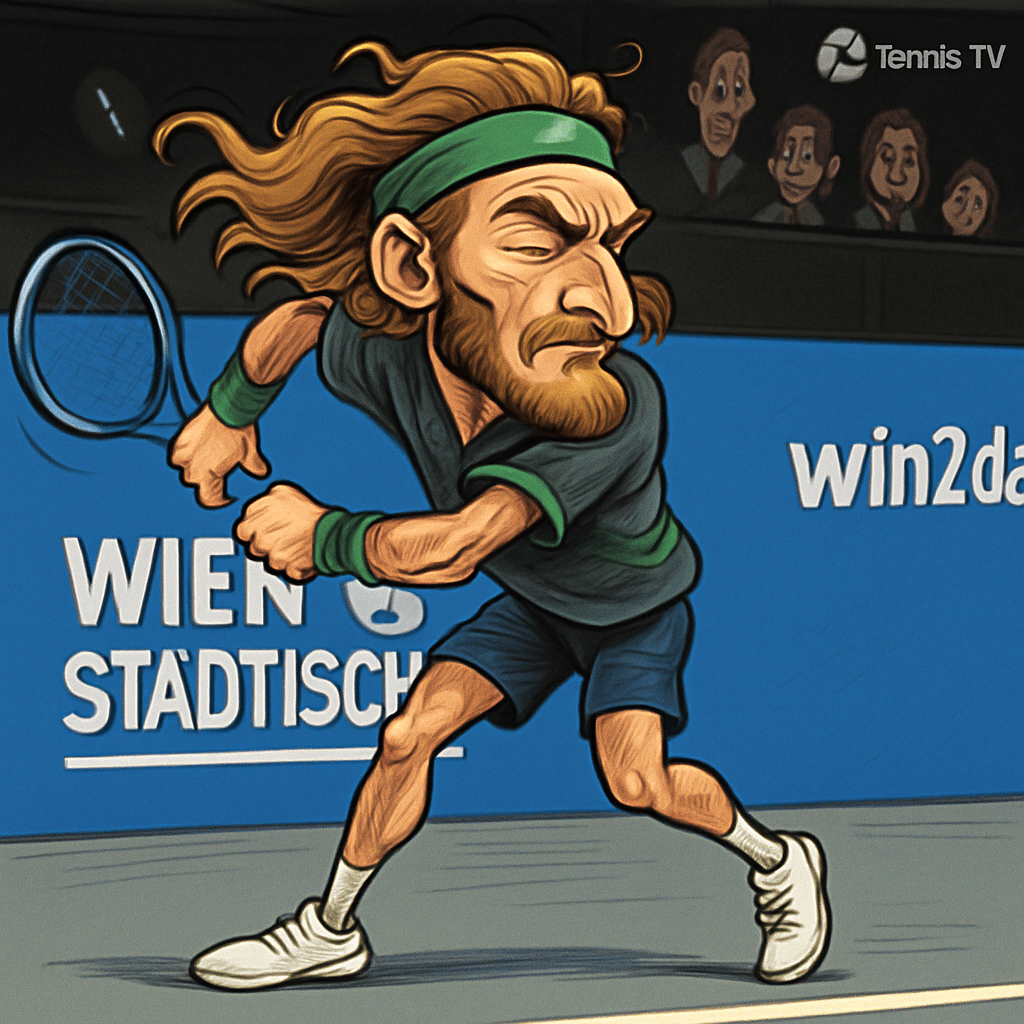VIENNA — Russian tennis star Andrey Rublev unleashed a furious racket-destroying outburst during his second-round match at the Erste Bank Open in Vienna, an explosion of frustration that resulted in a code violation from the chair umpire and ultimately contributed to his straight-sets defeat.
The World No. 6 was facing off against the rising young Italian Jannik Sinner in a highly anticipated clash. After a tight first set that went to a tiebreak, Rublev’s composure began to fray. The pivotal moment came early in the second set, with Sinner leading 2-1, when Rublev sent a forehand long, handing his opponent a crucial break of serve.
In a fit of pure rage, Rublev turned away from the court, raised his racket high above his head, and brought it down with devastating force on his own knee not once, but repeatedly. The carbon-fiber frame, unable to withstand the assault, splintered and bent into an unusable wreck. The violent act drew gasps from the crowd at the Wiener Stadthalle.
Chair umpire James Keothavong immediately issued a code violation for unsportsmanlike conduct. The incident seemed to suck the remaining fight out of Rublev, who went on to lose the match 7-5, 7-6(5). In his post-match press conference, a subdued Rublev offered no excuses, stating bluntly, "I think I deserve the code. I broke the racket, so I get a code. That's it."
A Pattern of On-Court Frustration
This is far from the first time Rublev’s fiery temperament has been on public display. The 26-year-old is known for his passionate, all-court style of play, but that passion often boils over into self-directed anger. Throughout the 2024 season, observers have noted an increasing frequency of these emotional eruptions, which have included:
- Screaming at his player's box and himself after unforced errors.
- Hitting himself in the leg or head with his racket.
- Previous, though less destructive, incidents of racket abuse during matches.
Tennis psychologist Dr. Elena Voropaev commented on the phenomenon, noting, "For a player like Rublev, whose game is built on high-risk, high-reward aggression, the line between controlled intensity and destructive anger is incredibly thin. When the shots aren't landing, that frustration has to go somewhere, and too often it is channeled inward or onto his equipment."
The Domino Effect on Performance
The immediate consequence of the racket smash was more than just a code violation; it was a tactical and psychological surrender. With his primary racket destroyed, Rublev was forced to use a backup, which often requires a period of adjustment for a professional player. More importantly, the emotional energy expended in the outburst appeared to leave him drained.
His opponent, the cool-headed Sinner, capitalized perfectly. The Italian later told reporters, "I saw what happened, of course. It's part of the game. For me, I just tried to focus on my next service game, to stay calm and play my tennis. In these moments, it is important not to get distracted."
This contrast in mental fortitude highlighted a key difference between the two top-10 players. While Sinner maintained a stoic focus, Rublev's error count rose following the incident. He failed to convert break point opportunities later in the set, and a double fault at a critical moment in the second-set tiebreak effectively sealed his fate.
The Official Rulebook Stance
The ATP rulebook is clear on such behavior. According to the "Unsportsmanlike Conduct" section, players are prohibited from "abusing rackets, equipment, officials, spectators or the court." The first offense typically results in a code violation warning, which is what Rublev received. A second offense can lead to a point penalty, and further violations can result in game penalties and even default. The Grand Slam rulebook is even stricter, with a history of issuing immediate point penalties for visible racket abuse.
Fan and Pundit Reaction Divided
Reaction to the incident on social media and among tennis pundits was mixed. Some expressed sympathy for Rublev, acknowledging the immense pressure top athletes operate under. Former player and commentator Brad Gilbert tweeted, "Tough to watch Rublev melt down like that. The guy cares so much, sometimes it works against him."
Others, however, were less forgiving, criticizing the display as unprofessional and a poor example for younger fans. One tennis journalist wrote, "There’s ‘passion’ and then there’s this. It’s a terrible look for the sport. Pure destruction." The debate underscores the fine line athletes walk between displaying raw emotion and maintaining professional decorum.
Looking Ahead: A Crucial Offseason
The defeat in Vienna is a significant blow to Rublev's hopes of qualifying for the ATP Finals in Turin. With only a few weeks left in the season, every match and every point is critical. The incident has sparked discussions about whether he needs to make a change to his support team, potentially bringing on a dedicated sports psychologist to help manage his on-court emotions.
Rublev himself has been candid about his struggles in the past. After a similar loss earlier this year, he admitted, "I need to find a way to be calm, to accept the mistakes. If I cannot control this, I will never win the big tournaments." The racket smash in Vienna serves as a stark reminder of that ongoing battle.
As the tour moves forward, the pressure will not relent. For Andrey Rublev, the path to unlocking his undoubted Grand Slam potential appears to be as much a mental challenge as a physical one. The destroyed racket in Vienna is more than just a broken piece of equipment; it is a symbol of a talent still wrestling with its own fiery nature, a battle that continues to play out in the full glare of the public eye.

